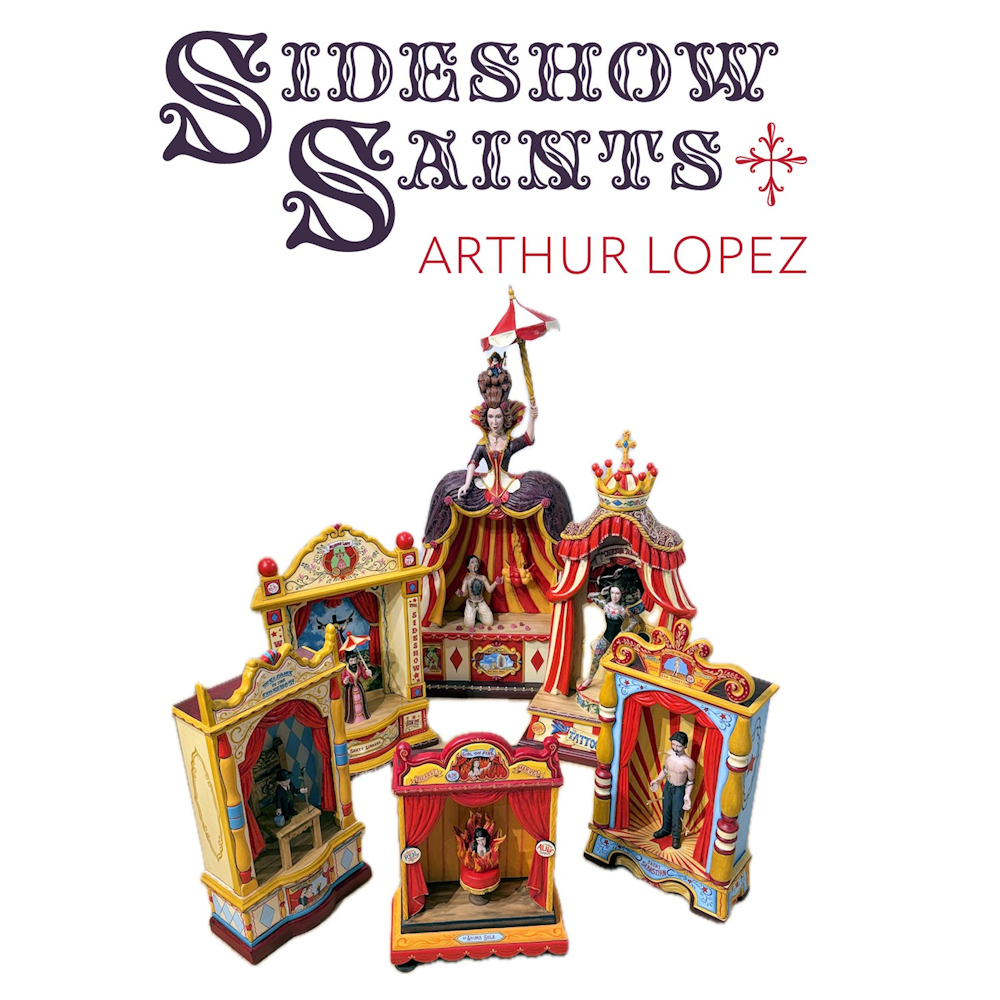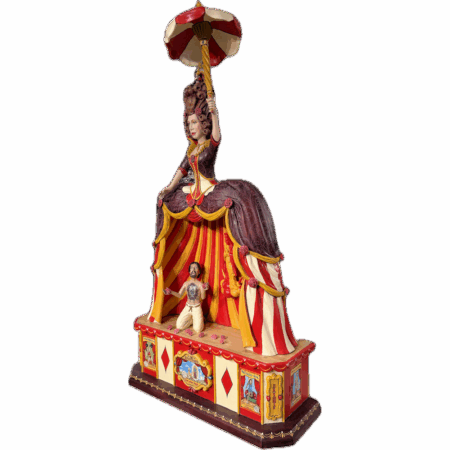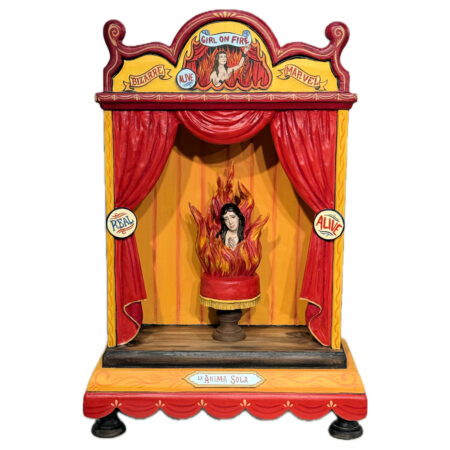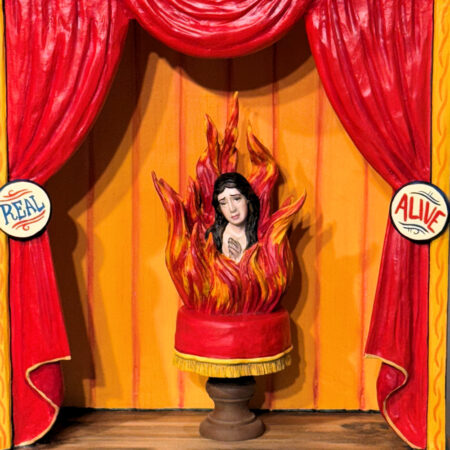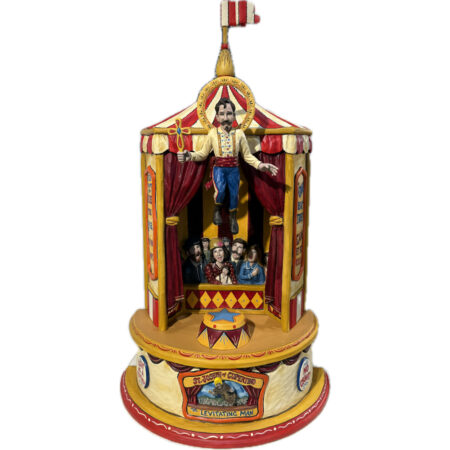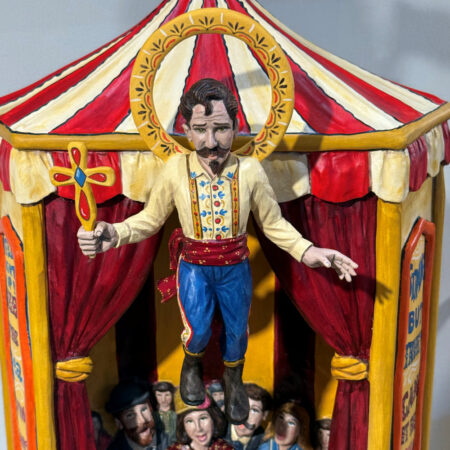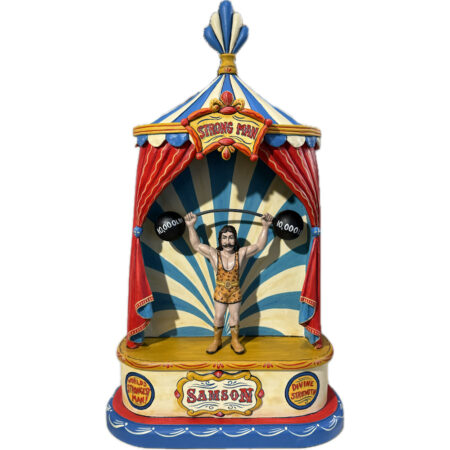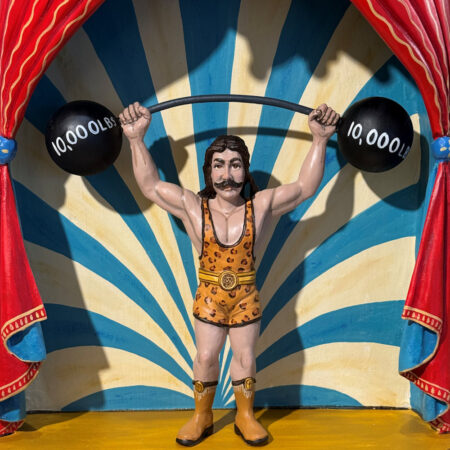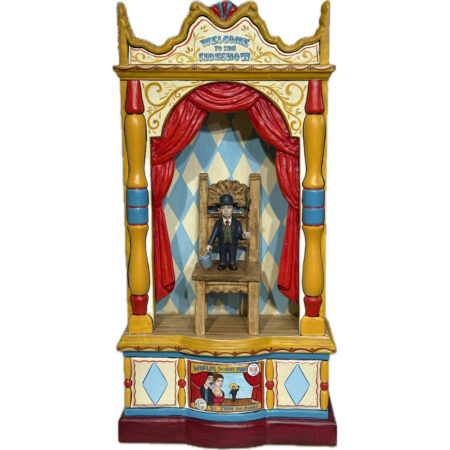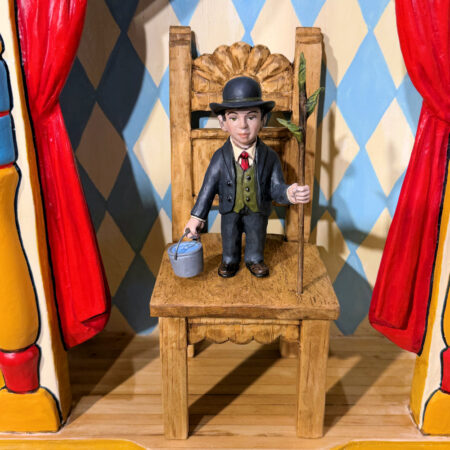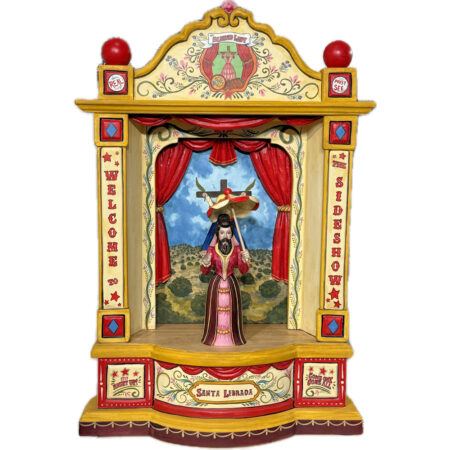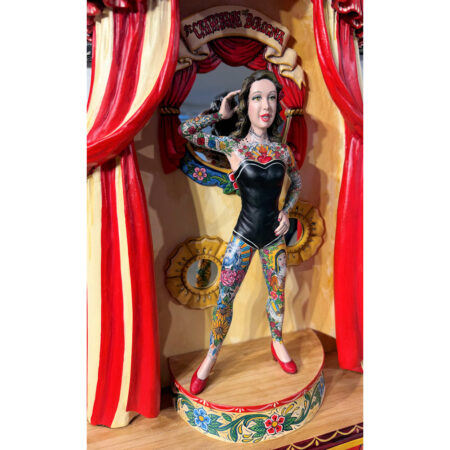King Galleries Blog
Arthur Lopez: Sideshow Saints

Arthur Lopez’s new exhibition, ‘Sideshow Saints,’ boldly reimagines the sacred narratives of Christian saints within the captivating and often unsettling world of the circus sideshow.”
“Step right up!” and witness a spectacle unlike any other! Prepare to be amazed, to be stunned, to be thrilled! Don’t miss your chance to witness the incredible! A sight you won’t forget, a memory you’ll cherish forever!
“Sideshow Saints” showcases Lopez’s exceptional skill in painted wood sculpture, a medium through which he meticulously reimagines traditional Christian narratives. Each piece in the exhibition demonstrates a profound understanding of form and surface, as Lopez masterfully carves and paints the wood to bring these unique interpretations to life. The tactile quality of the wood, combined with the vibrant layers of paint, imbues the sculptures with a tangible presence, bridging the historical narratives with a contemporary artistic sensibility.”
Lopez pulls back the circus curtain by inviting viewers into the world of circus sideshows, or (Freak-show) as it is sometimes referred to Circus sideshows are known for their bizarre and unusual acts that include people with unusual physical characteristics or conditions that were often considered “Freaks of Nature” or “Beyond Natural”. This concept sparked the theme for “Sideshow Saints.” Just as the sideshow spotlighted individuals with extraordinary characteristics, the lives of the saints are filled with equally extraordinary tales of martyrdom, miracles, and divine intervention. This parallel forms the foundation of the exhibition, where each figure is masterfully carved and painted with careful attention to their traditional attributes, reinterpreted within a sideshow setting.
Our Lady of the Sideshow: The Virgin of Guadalupe

 |
 |
 |
 |
 |
 |
41″ tall
“The centerpiece of the show, ‘Our Lady of the Sideshow, ‘ offers a nuanced allegorical interpretation of the Virgin Mary. Her elaborate Marie Antoinette-inspired coiffure, a symbol of royal power as ‘Queen of Heaven,’ also serves as a theatrical stage, reflecting her elevated status. Atop this towering hair sits the Christ Child of Atocha, a Roman Catholic image of the Christ Child, venerated in Hispanic cultures, as the patron saint of travelers, a fitting figure for the traveling circus. Her elegant gown is in the rococo style that drapes open like curtains to frame the stage for the sideshow acts that will perform. On stage is “The Apparitionist”, a contemporary depiction of “San Juan Diego”, a Mexican indigenous man to whom the Virgin of Guadalupe appeared in 1531. The Virgin of Guadalupe subtly blends into the background, and instead of the traditional miraculous image on his cloak, a tattoo of the Virgin of Guadalupe is strikingly emblazoned on San Juan Diego’s chest, surrounded by roses, a permanent testament to the divine encounter. Another striking interpretation is St. Sebastian, who traditionally is portrayed during his martyrdom by being shot with arrows, but miraculously survived. I portray him as the human pin cushion. Then there’s Santa Librada, a saint whose story involves a princess who grew a beard to avoid an arranged marriage. She was promised to a king, but devoted her life to Christianity and prayed for a sign to reject the marriage. Her prayer was answered with the growth of a beard, and she was later crucified by her father. In my sideshow, she becomes the Bearded Lady. With a clever twist, Saint Catherine of Bologna she is considered the patron saint of artists (due to her own artistic talents in miniature painting and illuminated manuscripts, and her dedication to her faith, which she expressed through her art and writings), becomes the tattooed lady, a fitting patron saint for tattoo artists in my sideshow.”
Girl on Fire: La Anima Sola
 |
 |
 |
20″h
Witness the flickering crimson glow that dances around her, a testament to the torment she endures! They say she wanders the desolate landscapes of purgatory, a solitary figure forever yearning for release! The Anima Sola, or “Lonely Soul,” is a devotional figure in Roman Catholic tradition, representing a soul in purgatory. It’s not a saint, but rather a symbolic figure who is suffering and waiting for purification before entering Heaven. Reaching out in need of assistance from both the living and God to ease her suffering. The Anima Sola is sometimes invoked for various intentions, including comfort in loneliness, healing from heartache, and even in matters of love.
The Human Pincushion: San Sebastian

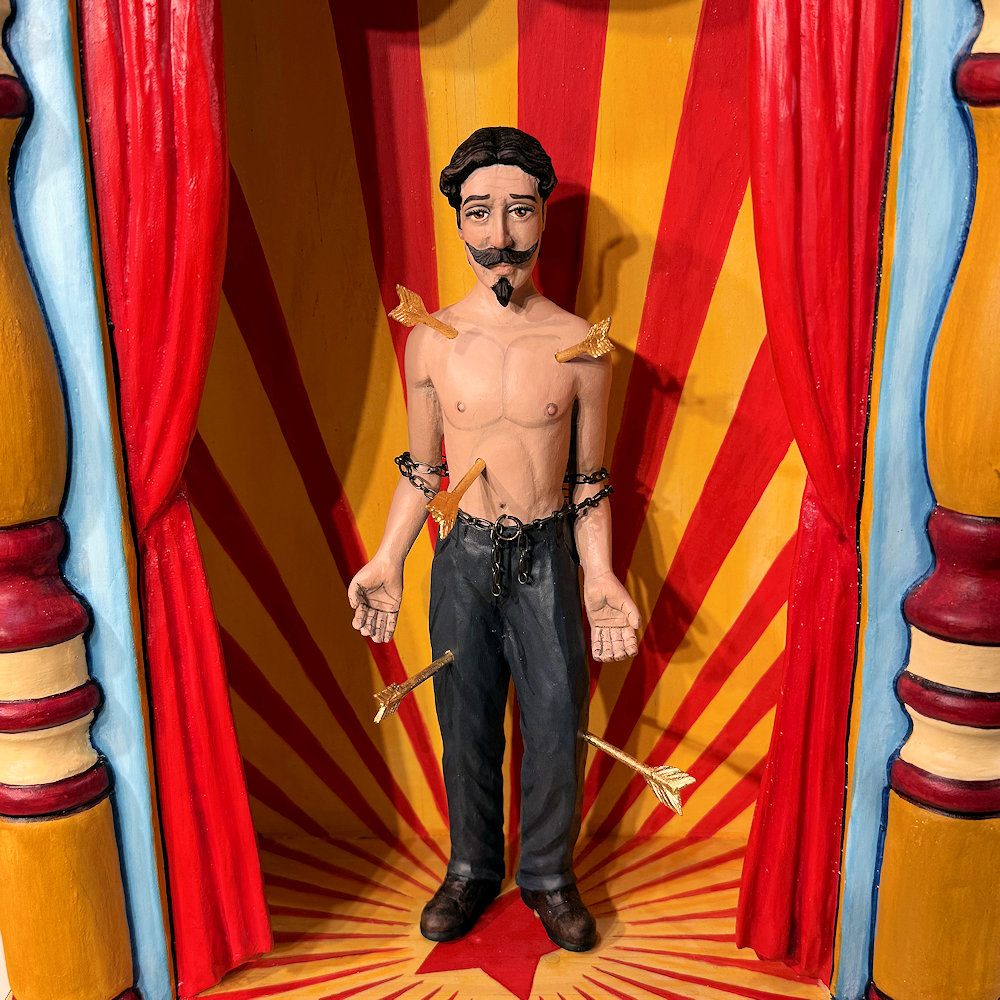 |
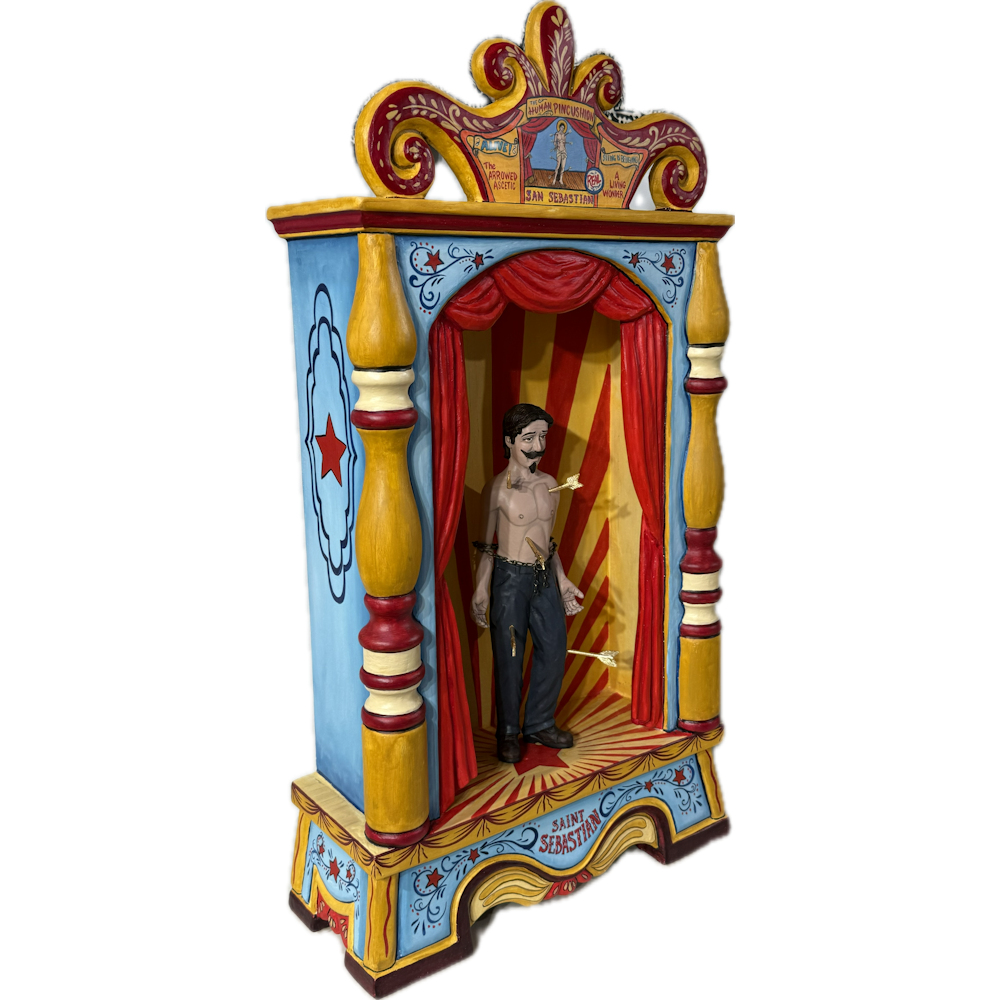 |
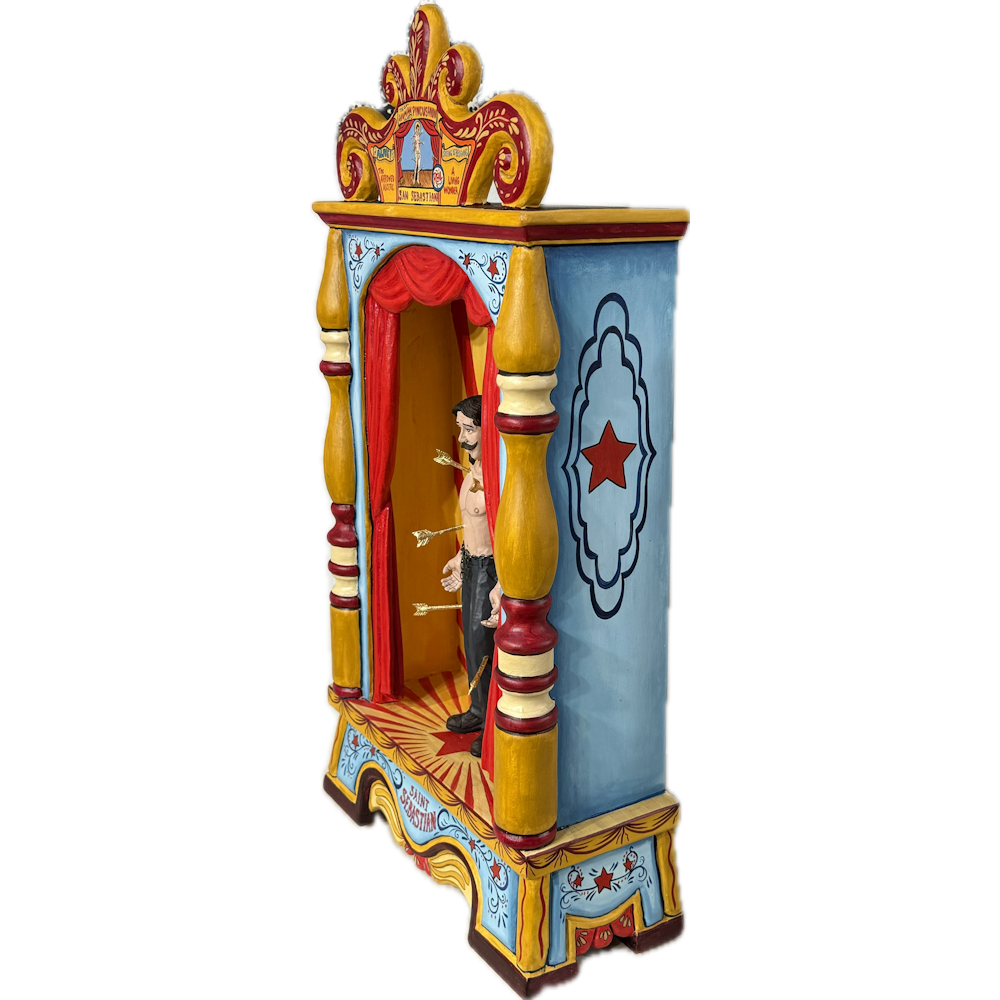 |
24″ h
“The Human Pincushion” Behold, The Human Pincushion! Once a Roman soldier, now a spectacle of stoicism! Saint Sebastian, a Christian martyr, is widely recognized as a symbol of strength, courage, and protection, particularly against plague and illness. He is also the patron saint of athletes, soldiers, and archers. “My sideshow interpretation of San Sebastian as the Human Pincushion symbolically represents the feelings of many. Often ridiculed for their appearance, beliefs, sexual orientation, ethnicity, or simply for being themselves, individuals who don’t meet societal expectations can feel imprisoned within their own bodies.” Arrows pierce his flesh, a testament to unwavering faith. He stands, a living tapestry of pain and devotion! A martyr for his beliefs, reborn as a marvel of endurance!
The Levitating Man: St. Joseph of Cupertino

 |
 |
 |
27″h
This piece is entitled “The Levitating Man: St. Joseph of Cupertino”.
The Strongest Man! Samson


|

|
 |
27″h
“Step right up, ladies and gentlemen, and behold the most astounding display of might!”
The legendary Samson, not in his typical biblical narrative, but re imagined as a quintessential circus sideshow strongman, lifting an impossibly heavy barbell with raw power and a touch of theatricality.
Samson stands center, his powerful physique rendered with exaggerated, rippling musculature that speaks to his divine strength. His shoulders are broad, his chest a barrel, and his arms, bulging are locked in the effort of the lift. His head, sculpted with a slightly theatrical grimace of effort, is adorned not with a crown, but with a wild, flowing mane of hair – his source of power – meticulously carved to suggest both immense volume and a hint of disarray from the strain. This hair cascades over his shoulders and down his back, almost becoming a part of the upright support of his stance. Every athlete seeks their “secret weapon” – a training regimen, a diet, a mental strategy. Samson’s hair was his. The story underscores that such “secrets” are often tied to discipline and sacrifice, and their abandonment can lead to loss of capability.
He is depicted wearing a leopard skin strongman’s uniform and a broad belt with a decorative lion head buckle another potent symbol of his untamed might.
The barbell itself is monumental with each “weight” at either end is disproportionately large, the bar connecting them is thick and sturdy, bowed slightly under the immense, implied weight.
Samson exemplifies how great physical gifts or talents can be squandered or become a source of downfall if not coupled with moral strength and self-control. In a world that often glorifies strength, wealth, or influence, Samson’s story reminds us that true power lies in integrity, wisdom, and alignment with a higher purpose. His inability to control his desires and impulses ultimately led to his tragic end, serving as a cautionary tale against self-indulgence.
The World’s Smallest Man: St. John the Dwarf




24″h
John the Dwarf is best known for his obedience. The most famous story associated with St. John the Dwarf tells of his elder, Saint Abba Pambo, who instructed him to plant a dry piece of wood and water it twice daily until it bore fruit. The water source was about 12 miles away, making this a seemingly pointless and arduous task. John obeyed without question for three years. Eventually, the dry wood sprouted, grew leaves, and produced fruit. Saint Abba Pambo then took the fruit to the other monks, saying, “Take, eat from the fruit of obedience.” This story became a powerful illustration of the virtue of obedience.
“Yet, this remarkable act of obedience was just one facet of the wisdom held within his small frame.” This vertically challenged wonder, this paradox of small stature and immense spirit, often shared profound insights that belied this small wonder. He urged all to look beyond the flaws of others, a lesson perhaps learned from a lifetime of being scrutinized himself. He cautioned against the folly of comparison, a wisdom surely gleaned from navigating a world built for those of greater height. Though short in stature, his faith was larger than life. He stressed the need to pay no attention to the faults of others and to avoid comparing oneself to others.
Behold, then, Saint John the Dwarf! A reminder that true measure lies not in inches, but in the boundless capacity of the human heart, a truth perhaps most powerfully illustrated in the life of one so remarkably small. Make no mistake, within this pocket-sized being beats a heart of unwavering devotion!
The Bearded Lady: Santa Librada


|

|
 |
26″h
“Come closer! Witness the legend of ‘The Bearded Lady’, Santa Librada, a figure who embodies liberation and strength for every unconventional soul! Behold the incredible princess from a foreign land, bound by a sacred vow, whose defiance became a miracle.”
Santa Librada, also known as St. Wilgefortis, is a female saint whose legend, appearing around the 14th century, was the daughter of a pagan king of Portugal and had converted to Christianity, taking a vow of virginity. Her father had arranged a marriage between her and a pagan king. As she had devoted her life to Christ, she prayed to God to disfigure her body to avoid an unwanted marriage. According to the legend, she prayed to God to grow a beard, which she did, and her suitor then withdrew his proposal. Enraged, her father had her crucified, making her a martyr.
The Bearded Lady, Santa Librada (whose name means liberated) isn’t just a curiosity; she’s the patron of the downtrodden! For women yearning to escape the chains of abuse, for souls trapped in unwanted situations, she is their whispered prayer, their silent scream for LIBERATION!
Librada’s story, particularly the beard growth, has been interpreted as a symbol of rebellion against societal expectations and gender norms. This interpretation has led to her being embraced by LGBTQ+ individuals and communities seeking to reclaim and redefine their identities within religious contexts.
The concept of “queer saints” is gaining traction, with Santa Librada being a prominent figure. Her legend is seen as challenging traditional gender and sexuality norms, providing a space for LGBTQ+ individuals to connect with their faith and find a sense of belonging. She challenges the rigid rules and embraces the unique, offering a sanctuary of belonging for all who seek their true selves in the eyes of the divine. She is the ultimate symbol of reclaiming.
The Tattooed Lady: St. Catherine of Bologna

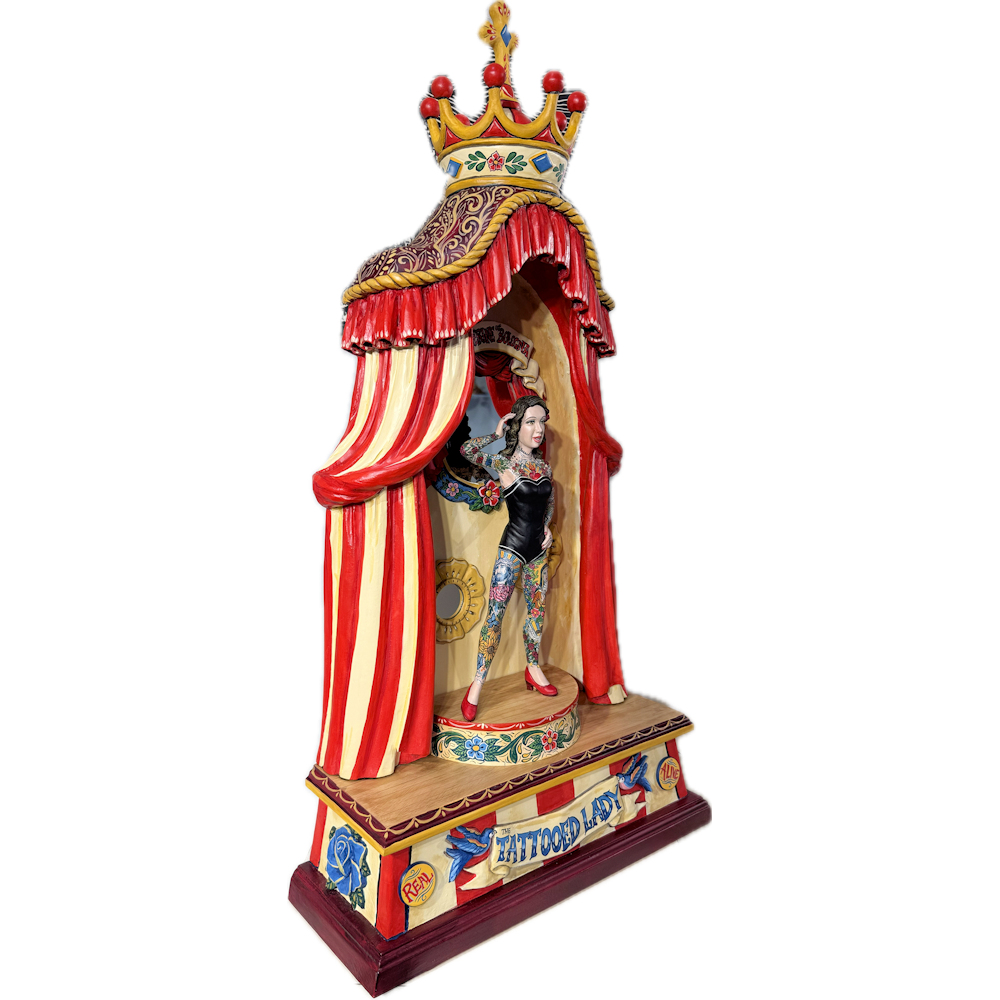 |
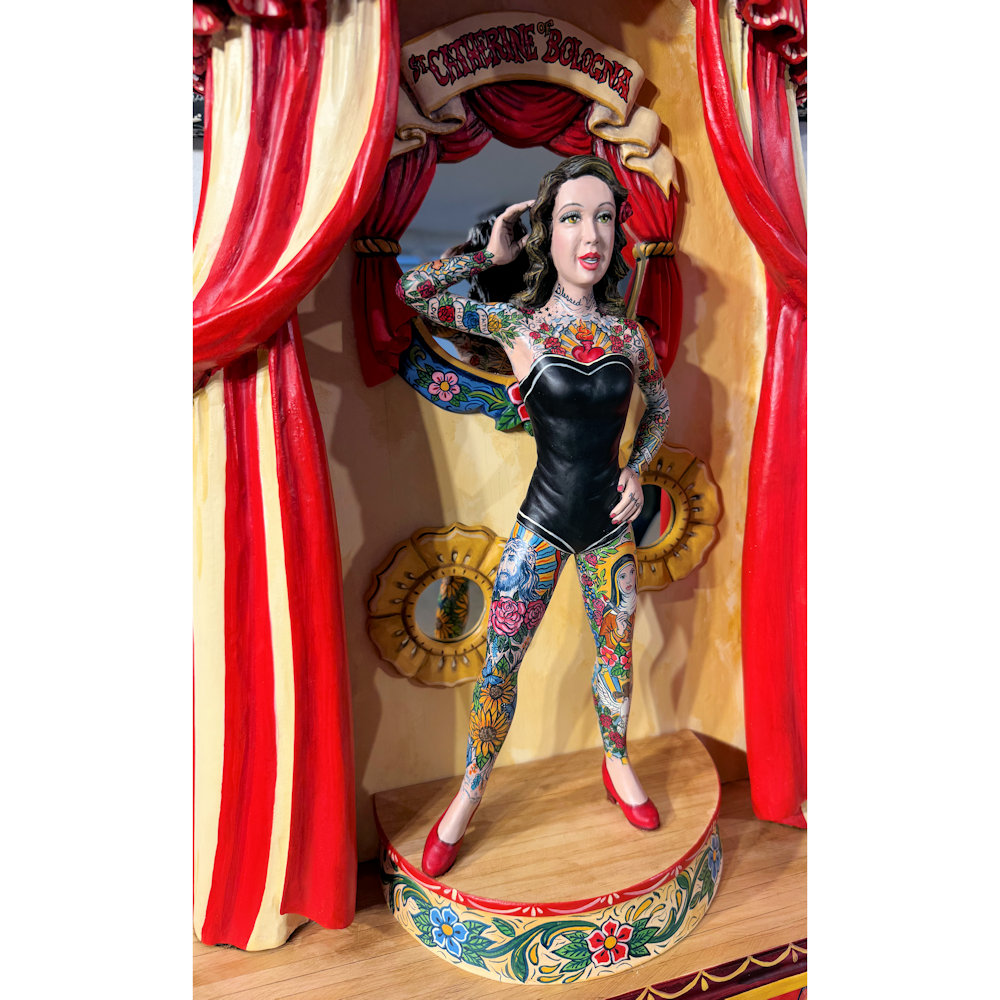 |
 |
33″ h
St. Catherine of Bologna, the Holy Hand that Guides the Needle!
Catherine was born in 1413 to an aristocratic Italian family. Her father was a diplomat and professor of jurisprudence who sent her to the court of Niccolo III d’Este in Ferrara at age 11. Here St. Catherine received a good education, including Latin, music, painting and calligraphy. She would later use these skills to copy and illuminate prayer books and other manuscripts. Determined to live a life of perfection, Catherine left the court and became a Franciscan Tertiary at the age of fourteen and dedicated her life to Christ she traded palace life for a nun’s habit. Soon, she embraced the strict Rule of St. Clare, and Catherine fully dedicated herself to the Poor Clare way of life, embracing vows of poverty and humility. She began to experience visions of Christ and satan but through it all, her faith and visions inspired her art.
As a nun, St. Catherine spent time copying breviaries, which she adorned with small images and other decorations. This activity was a form of mystical meditation for her illuminated manuscripts and were considered to be simple models of St. Clare’s lifestyle as they called to mind the humility of the Poor Clares’ vows. St. Catherine also pursued other artistic interests, playing the viola and painting religious pictures.
So, when the needle sings and the ink flows, remember St. Catherine. She’s the guiding hand, the inspiration for every beautiful line and shade. For all you bold souls with art on your skin, know that St. Catherine of Bologna lends her silent, sacred blessing to every masterpiece, the unlikely patron of body art!

Arthur Lopez (b.1971) said, “I firmly believe that you can still use traditional methods to create contemporary work.”
Though most of Arthur’s work represents Saints, you do not have to be of any particular religion to appreciate them as art. Equally crucial to López is his need to transcend the bounds of the traditional santero and use his art to express the full range of his culture and the world around him. López has exhibited in numerous shows throughout the Southwest and is in many prominent museum collections nationwide. His work has been exhibited internationally at the 2nd International Triennial of Kogei – “The Arts Grounded in Region,” 21st Century Museum of Contemporary Art, Kanazawa, Japan; “Song of the West,” Kohi Kulturaum, Karlsruhe, Germany, and “The Saints From a Land So Remote” – LAProjects, Landshut, Germany. Arthur Lopez was born and raised in Santa Fe, New Mexico, and he is proud to be working in the long tradition of New Mexico santero artists. His keen attention to detail has garnered him many awards, and he is highly esteemed as one of New Mexico’s most popular santero wood sculptors. In 2015 Arthur Lopez was awarded the City of Santa Fe Mayor’s Award for Excellence in the Arts and the New Mexico Governor’s Award for the Arts in 2022. “My work comes out of my faith.”


